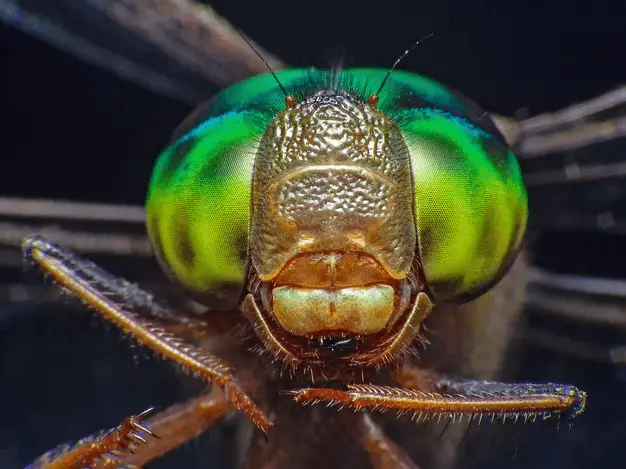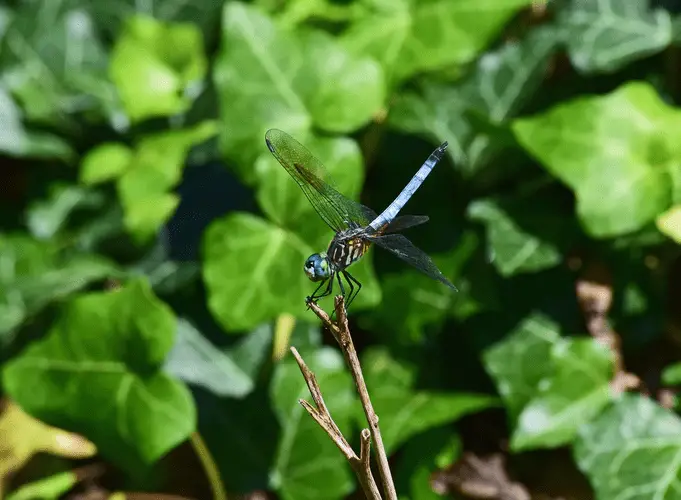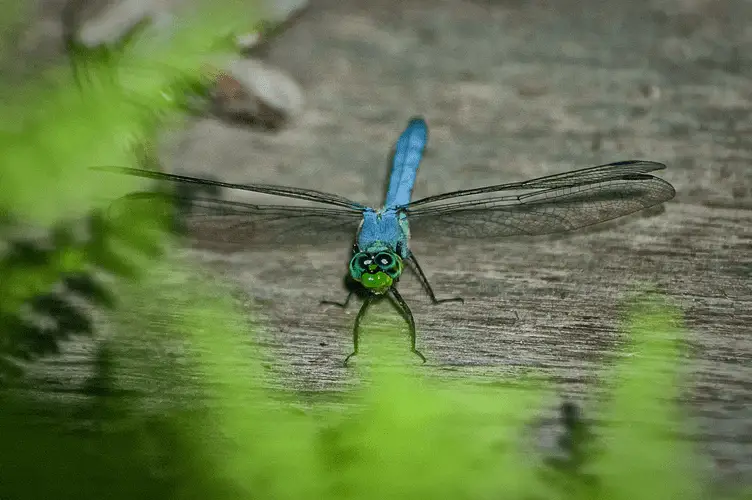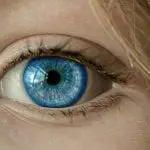When you think of fascinating things that are blue, an insect is the last creature that would come to your mind. A beautiful blue eye, the blue sea, or even a blue umbrella might be your first thought.
But, can you think of a flying insect that’s also a fascinating thing that is blue?
Most insects are disgusting, I agree because they usually bite you. But there is a fascinating insect, blue color that has inhabited the planet for a long time. It is a dragonfly or the ‘blue dasher’. There’s something magical about these flies and do you know what makes them so special and magical?
Similar to the beautiful slender ‘damselflies’, the Blue Dasher has a distinctive coloring that sets it apart from other dragonflies. The dorsal part of the abdomen in bluish color with a yellow-striped thorax. The eyes are exquisitely distinct being jade-green in males and reddish-brown in females. A distinct blue colored body of the adult male makes them attractive. Females though are slightly less colorful with a brown-colored abdomen.
Here’s a list of interesting facts about these tiny blue creatures:
Dragonflies evolved around 300 million years ago, and they were one of the first winged creatures to evolve from the water where they are born. Though the body grows only up to two inches (5.08 cm), their wingspan ranges from 2-5 inches (12.7 centimeters). Research has shown that early dragonflies have wingspans of up to 2 feet (0.61 m) which might also contribute to their unique species name.
1. Found abundantly in the United States.
The Blue Dasher is mostly found across the United States and some islands surrounding it. It cannot be found in the mountain regions and inhabits lower elevated regions. They are usually found near water bodies such as lakes, ponds, streams, all of which are at a low elevation. The Blue Dasher is known as Summer Species and flies from Late June to October.
2. Blue Dasher-The Swift Long Winged Skimmer.
The blue dasher is biologically known as ‘Pachydiplax Longipennis’, which belongs to the skimmer family. ‘Longipennis’ means ‘long wings’, ironically though the dragonflies of this species have wingspan similar to those of other species. The reason for this name might be the female Blue Dasher, whose peculiar body with a small abdomen makes the wings appear longer.

3. Initially they are aquatic creatures, living there up to 2 years.
Dragonflies lay their eggs in water which allows the larvae to hatch only in water. These larvae also known as Blue Dasher Naiad, live underwater up to 2 years after hatching. They spend this time in the aquatic vegetation, feeding on other aquatic larvae.
After they mature, they surface to the air to molt their bodies. Once they are mature adults they take flight into the world.
While underwater, these Naiads eat anything they can- tadpoles, mosquito larva, fish, and even other insect larvae. The larva crawls out of the water towards the end of the larva stage when the exoskeleton cracks open, exposing the abdomen of the insect. Over the next few hours, the soft wings harden and prepare for flight.
Since the Blue Dasher Nymphs are tolerant to low levels of dissolved oxygen in the water, scientists believe their presence is an indication of low water quality.
4. Nymphs breathe through gills.
The Blu Dasher Naiads are also called Nymphs. Their rectum is equipped with gills that allow these young creatures to survive underwater for long periods as two years. The rear end of the fly functions to separate oxygen from water allowing them to breathe. Apart from this rectum also functions as the usual waste disposal organ helping the larva to excrete underwater.
5. The DragonFly is ‘All Eyes’
The head of the Blue Dasher is made up of eyes, completely! Also termed a ‘Blue Pirate’, they have compound eyes which are made up of thousands of tiny eyes. This allows them to have a 360-degree view, see in every direction and detect motion almost anywhere, except right behind them.

Additionally, they can see ultraviolet rays and colors beyond human vision. This makes a powerful predator even underwater where they can keep an eye on the prey while avoiding all collisions.
6. Skilled Flier and Engineering Marvels.
The flying skill of these dragonflies has inspired several scientists and engineers because of their unique and unmatched flying ability. The dragonfly has two sets of wings that can work independently while being attached to muscles in the thorax region. This allows them to change direction in the air by changing the angle of each wing. They are agile flyers and can fly in every direction, in addition to hovering at a spot for more than a minute.
7. Predators with spectacular hunting skills
Since they are expert fliers with speeds only a few other insects can match, they are deadly predators that feed on their prey while flying. With a strike rate of 95%, the dragonfly creates a basket-like shape with its feet to hold the prey. With the combination of an almost360-degree sight and unique flying ability, the Blue Dasher is one of the deadliest predators among insects.
8. Can starve to death if injured.
Adult Dragonflies are gluttons and can eat up to 10% of their body weight each day. They are carnivorous and prey on other insects especially mosquito larva. But they have a unique dining style because they feed only when they fly. After grabbing the prey with strong feet, they bite and eat them while flying. And if they are injured by any chance, they will starve to death.
9. They intercept prey mid-air.
The Blue Dashers might be magical and innocent creatures to humans. To insects, they are deadly enemies. These flies calculate aerial ambushes and ambush their prey from blindsight. Mid-air they hitch the prey from behind and are almost always successful in catching the prey.
The Blue Dasher is known for being a vicious predator but it is also very patient. The Blue Dasher keeps still and waits for the prey to fly within its range. As soon as it does, it darts at the prey using its agile flight and captures the prey.
10. Additional Strong Jaws.
The mandibles, otherwise known as jaws, are quite muscular and strong. Apart from possessing incredible hunting skills the dragon fly’s brawny ability to rip apart its prey makes it a lethal enemy and prey.
The Blue Dasher falls under the order Odonata which means “toothed ones” in Greek. The serrated mandibles are the reason for this title. Fortunately, they cannot bite humans since most of the species are not equipped with mandibles sturdy enough to break through human skin.
11. Can stand on their heads.
The Blue Dasher is accustomed to cooler, damp climates. During hot days when temperatures can become unforgiving, the Blue Dasher sits on its perches to control the body’s internal temperature. It holds its abdomen straight up in an ‘obelisk’ position, as scientists have termed it, to stay cool. In this position, they turn their bodies according to the position of the sun.

12. Friends of Human Beings.
By now you might have figured that the Blue Dasher preys on most insects which ultimately reduces the number of insects that bother human beings. Their primary dietary preference is a mosquito, and each dragonfly can eat up to 100 mosquitoes in a day.
Apart from contributing to making the environment insect-free they also inspire humans to engineer new technology in the aerial sector.
13. Unique Symbolism.
Dragonfly symbolism has fascinated people for centuries. Considered among a few as ‘blue emperor dragonfly’, the Blue Dasher’s color symbolizes loyalty, truth, faith, and wisdom.
Dragonflies have also been the friends of fishermen in the past. Where they hovered, fishermen considered the abundance of fish and if they hovered over the fishermen, it was thought to bring good luck.
In pagan cultures too dragonflies, especially the Blue Dasher, was given a magical attribute because of their changing colors with age.
Conclusion
Giving back to these beautiful creatures in blue, human beings can contribute towards the conservation and their protection. Human Being’s activities have created pollution and habitat loss that threatens the survival of these friendly creatures.
Sanctuaries around the world are focusing on the preservation of these things in blue. ‘The Dragonfly Centre’ is the United Kingdom’s first dragonfly sanctuary established in 2009. ‘The Dragonfly Sanctuary Pond’ situated in Albuquerque, New Mexico, is the first pond sanctuary in the US and is home to a diverse species of dragonfly and damselfly.



